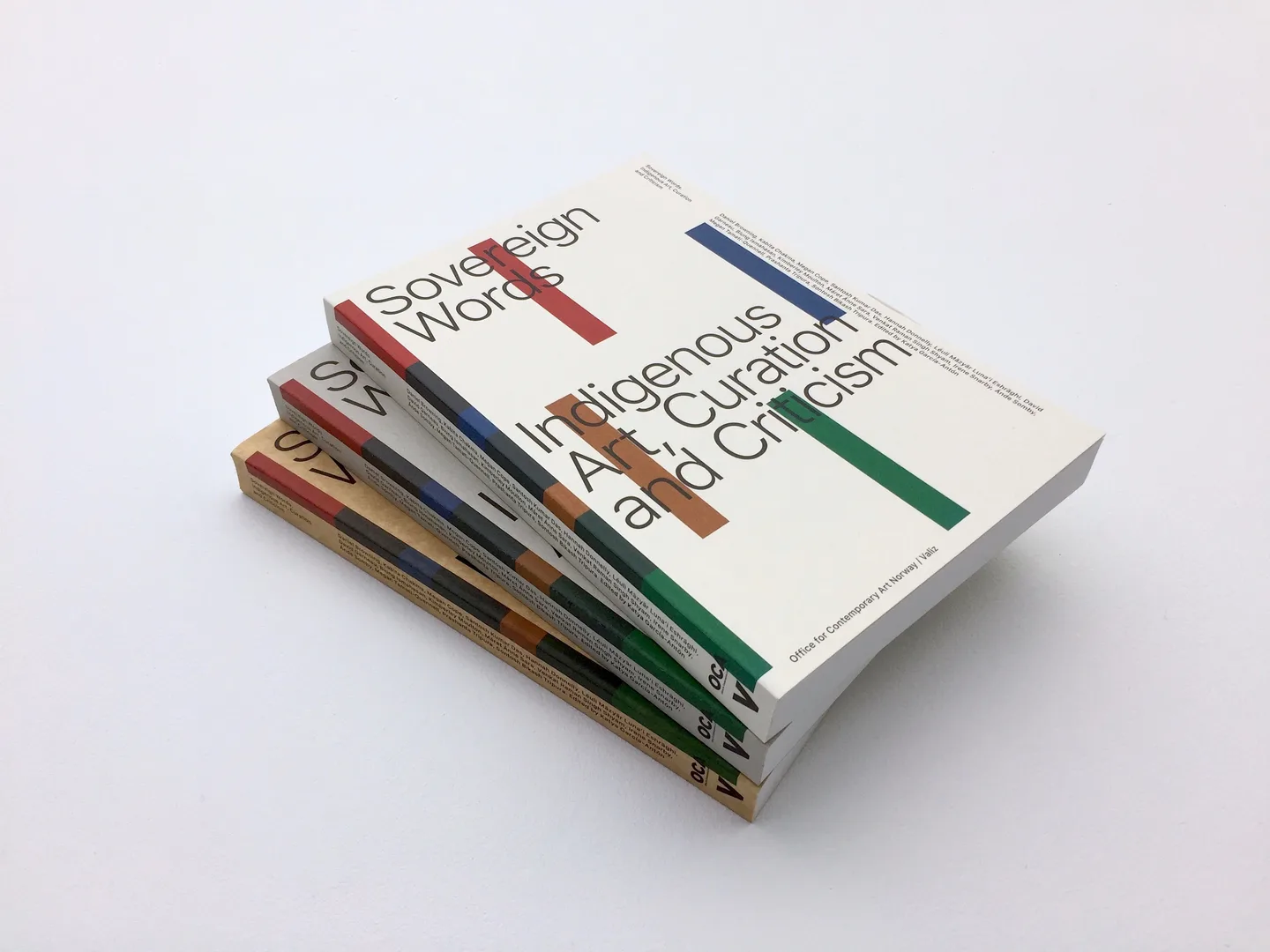
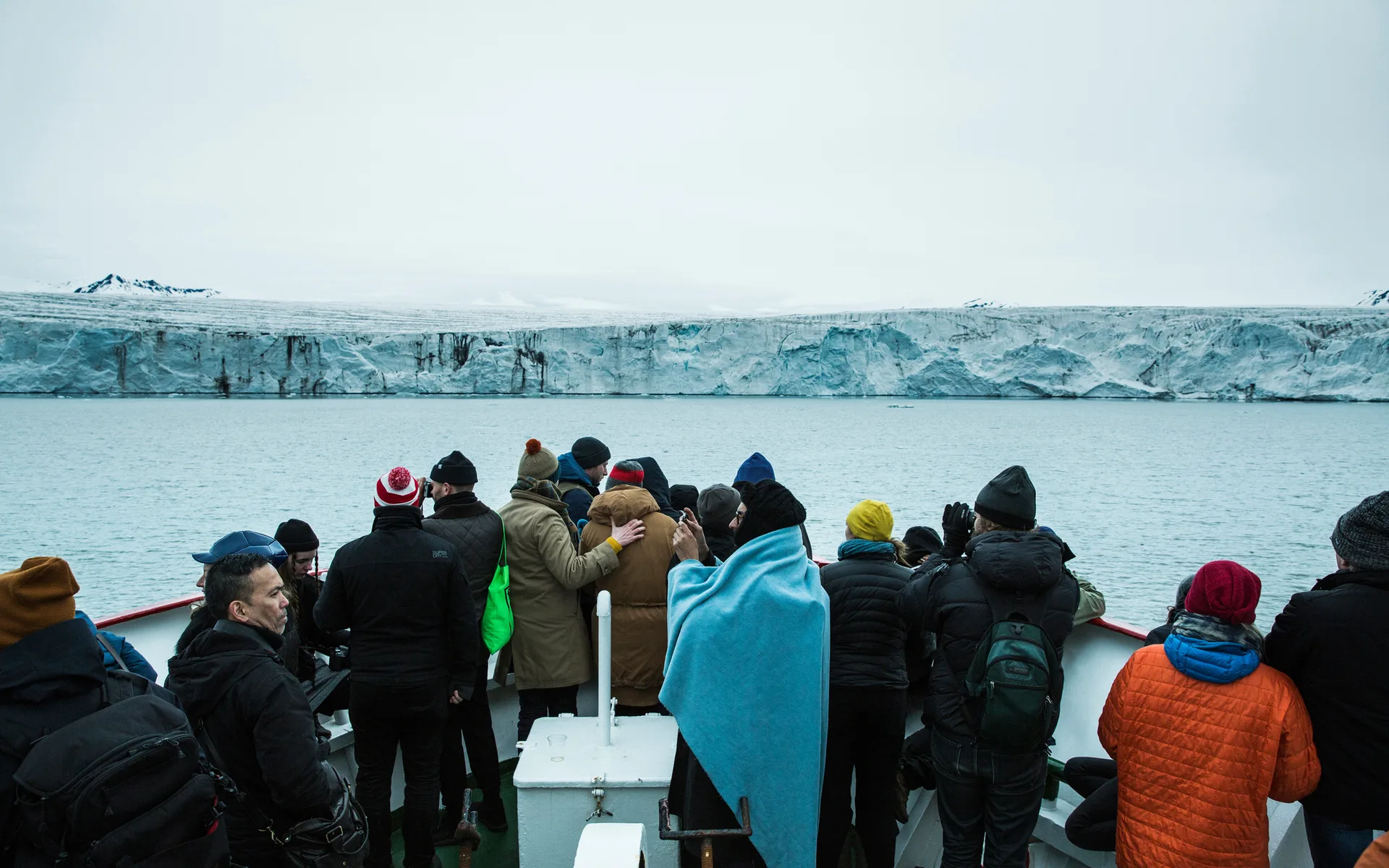
Longyearbyen
Thinking at the Edge of the World
'Thinking at the Edge of the World’ was a cross-disciplinary international conference held on Svalbard from 12-13 June 2016, initiated and developed by OCA and the Northern Norway Art Museum (NNKM). It brought together figures from the fields of art, architecture, psychology, philosophy, history and science, who were invited to visit and think about the region, considering it as a unique vantage point from which to reflect upon the environmental, aesthetic, architectural, economic, political and scientific forces that are shaping the North of Norway and its relationship to the world.

(l-r) Magne Furuholmen (Queen Sonja Print Award), Katya García-Antón (Director, OCA), Linda Hofstad Helleland (Norwegian Minister of Culture), Jérémie Michael McGowan (Director, NNKM) © OCA / Herman Dreyer
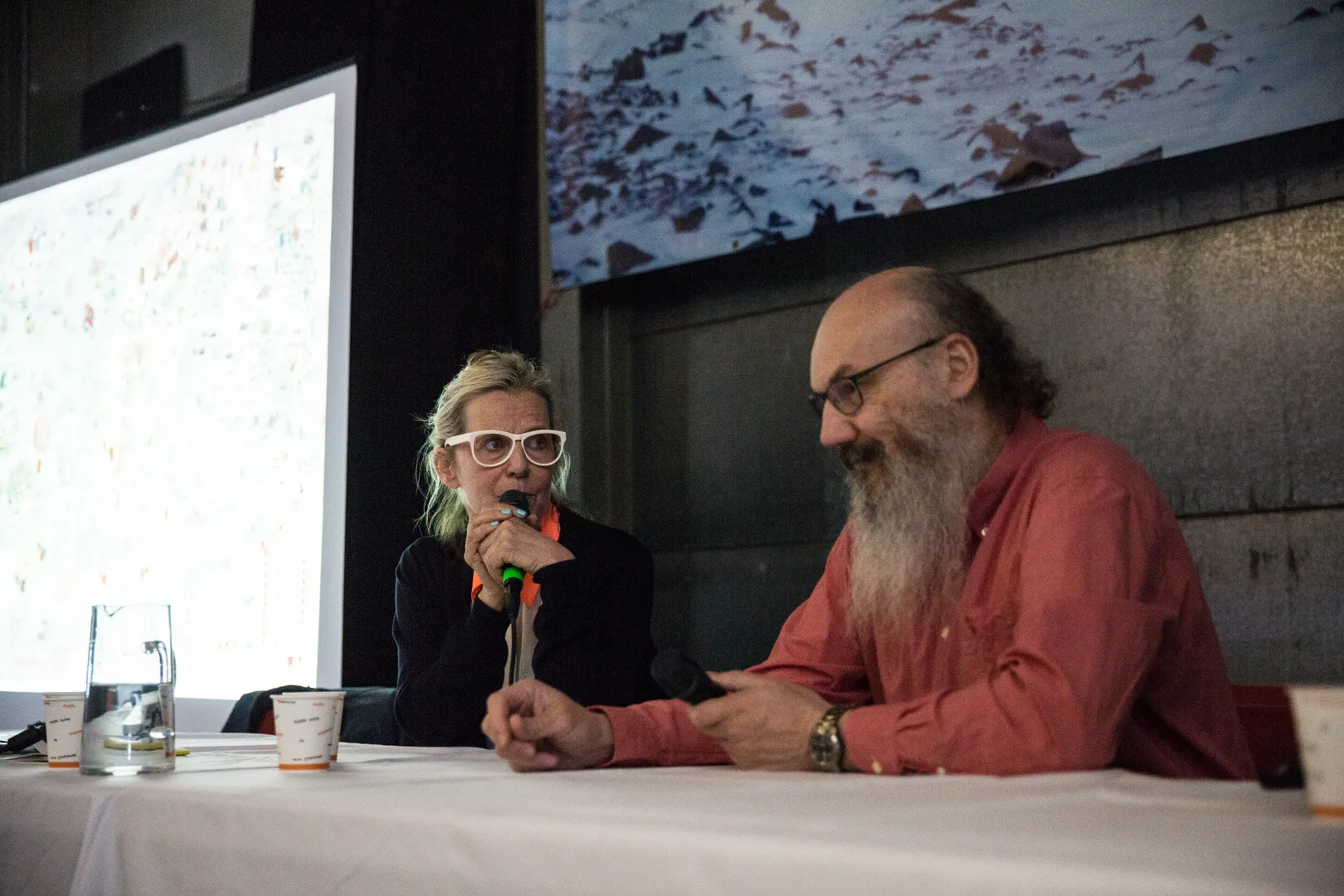
(l-r) AK Dolven in discussion with Kim Holmén, International Director of the Norwegian Polar Institute © OCA / Herman Dreyer
How are frontiers questioned from an Arctic vantage point, and how might this questioning catalyse new thinking regarding territory, power and resource exploitation? Could concepts of society, aesthetics and community explored during the nineteenth and twentieth century – often led by artists and intellectuals from Norway and its indigenous communities – be sought again to enlighten this debate?
The conference coincided with the opening of a solo exhibition by the Norwegian contemporary artist Olav Christopher Jenssen at Northern Norway Art Museum’s Kunsthall Svalbard in Longyearbyen. The exhibition features new work inspired by Jenssen’s recent residency project with Kunsthall Svalbard.
Programme higlights included a conversation between Candice Hopkins, Chief Curator at The IAIA Museum of Contemporary Native Arts in Santa Fe, and legendary journalist and Sami political rights activist Niillas Somby, as well as Lisa Philips, Director of New Museum in New York; Robert Templer, Director of The Center for Conflict, Negotiation and Recovery, Central European University, Budapest, Hungary; Elena Isayev, Professor of Ancient History at the University of Exeter, UK; Ute Meta Bauer, Founding Director of NTU Centre for Contemporary Art, Singapore; Luba Kuzovnikova, Director of Pikene på Broen, Kirkenes; Julie Decker, CEO and Director of Anchorage Museum, AK, USA; Sami poet and visual artist Synnøve Persen; and AK Dolven, one of Norway’s foremost visual artists. A panel discussion on the future of the oceans was complemented by a special screening of Leviathan, an experimental work about the North American fishing industry by Lucien Castaing-Taylor and Véréna Paravel, and Kim Holmén, International Director of the Norwegian Polar Institute, lead a boat trip to the glacier front.
Other elements of the diverse programme included a 24-hour sensory intervention and scent workshop devised by design historian, writer and curator Emily King with leading perfumer Nadjib Achaibou.
Programme
Saturday 11 June 2016
PRE-PROGRAMME
Venue: Kunsthall Svalbard
8.30pm
Exhibition opening
Olav Christopher Jenssen: The Expedition
Curated by Jérémie McGowan
Northern Norway Art Museum opened Kunsthall Svalbard in 2015 as a dedicated exhibition and project space for interna-tional contemporary art. The Kunsthall’s inaugural Artist in Residence project presents a series of exploratory probes by Olav Christopher Jenssen into the biolog-ical, geo-political and cultural aspects of Svalbard’s contemporary landscape. Jenssen brought with him to Longyearbyen two custom-made expedition cases, each housing 25 aluminium plates upon which to record and react to his experiences in the Arctic. These plates are informed in turn by a group of over 200 watercolours that served as an initial mode of investigation and capture. Added to this are elements transposed from Jenssen’s temporary studio in Longyearbyen, a makeshift atelier inhabited by zoological specimens from the old Svalbard Museum. The underlying experimental nature of ‘The Expedition’ resonates with previous histories of Arctic exploration imagery, while simultaneously linking to the wide spectrum of scientific research activities central to Svalbard’s identity today.
Sunday 12 June 2016
PROGRAMME
OCEANS, FOOD, MYTHS, AND SEA MONSTERS
Venue: Cinema Kulturhuset Longyeabyen
A series of screenings and conversations unfolding the narrative constructions around oceans, alongside a panel of film-makers, anthropologists, artists, Arctic marine biologists, curators and writers. The panel, and correlated activities, debate the realities of life in the Arctic, its peoples and ecosystems, the future and past of water fluidly in relation to global food and survival systems, and the human obsession with the deep.
12am
Film screening
Leviathan (2012, 1h 27m), dir. Lucien Castaing-Taylor and Véréna Paravel
Leviathan is a work of nonfiction set entirely on a groundfish trawler departing from New Bedford, Massachusetts, the very port from which Herman Melville’s Pequod gave chase to Moby Dick. Avoiding standard equipment and traditional interviews, analysis and explanation, Leviathan impressionistically captures the collaborative clash of man, nature and machine. Shot on a number of small cameras – passed from fisherman to filmmaker – it is a cosmic portrait of one of humankind’s oldest endeavours.
LANDS, SETTLEMENTS, TIPS, BONES AND APPROPRIATION
Venue: Lecture hall, University of Svalbard (UNIS), Entry through Museum of Svalbard
A series of conversations around concrete and metaphorical notions of land addressing their conquest, domestication, and demo-graphics, as well as the socio-political and environmental crisis unleashed by the changing processes of climate, occupation and settlement. The session opens with a particular reference to the Nordic north as it considers the conflicted history of that region’s Sami people (the largest indigenous community in Europe) whose nomadic life-style has been challenged in modern times by questions of ownership and usage of land and its resources, nation states and borders, mobility and belief. The participants include Sami activists and artists, highlighting economic, spiritual, historical, legal, environmental, aesthetic and poetic questions. Indigenous alliances to connect apparent local issues with global ones are also explored.
9.50–10am
Welcome
Katya García-Antón and Jérémie McGowan
Katya García-Antón is the Director of the Office for Contemporary Art Norway
Jérémie McGowan is Director of Northern Norway Art Museum
10–10.45am
Conversation
Candice Hopkins and Niillas Somby
Candice Hopkins and Niillas Somby Calling forth the experiences of indigenous communities across diverse landscapes and cultures, Candice Hopkins and Niillas Somby will discuss the forms and language behind historical and contemporary politics of resistance. Taking the perspectives of arts and activism as a starting point, their discussion will link circumpolar and global debates on the subject.
Followed by Q&A
Candice Hopkins is a curator and writer based in Albuquerque, New Mexico and a curatorial advisor for documenta 14, opening in 2017.
Niillas Somby is a Sami writer and political rights activist
11am–12pm
Panel discussion
Panellists: Robert Templer, Lutz Henke, Elena Isayev and Alberto Altés. Moderated by Katya García-Antón
Across the world the explosion of numerous old and new conflicts (armed and environmental) are leading to large-scale displacement of communities searching for new homes, temporary refuge or permanent asylum for political or economic reasons. Their movements catalyse complex debates regarding social friction and intolerance, as well as the nature of our planetary responsibility to others. If the paucity of a welcoming infrastructure within receiving nations has become a crisis in itself, these social displacements are enabling new forms of political brinkmanship. Terms like ‘crisis,’ ‘migration,’ ‘exploration’ and ‘conquest’ continue to pervade modern and mediatic global rhetoric. The Cold War confrontations of old once again inform many territorial debates. Yet evidence from the ancient world challenges our current understanding of social displacement, reminding us of the more quotidian historic nature of mobility. This panel sets forth aesthetics propositions, technological queries, and architectural responses to look at other forms of mobility and territorial usage that can stoke a rethinking of Arctic and world geopolitics.
Robert Templer is Director of The Center for Conflict, Negotiation and Recovery, Central European University, Budapest, Hungary
Lutz Henke is a cultural scientist and curator based in Berlin, Germany who recently collaborated on the project Black Flag by artist Santiago Sierra, in the North and South Pole
Elena Isayev is Professor of Ancient History at the University of Exeter, UK
Alberto Altés is an architect, researcher and lecturer at Umeå School of Architecture, Sweden
12–12.30pm
Conversation
Olav Christopher Jenssen with Jérémie McGowan
Framed within a critical historiography of Arctic exploration, its attendant expedition imagery, and the varying discourses about the Artic that such images have spawned, this dialogue explores the ways in which the north is both imaged and imagined. Held in proximity to one of the world’s leading research parks for Arctic studies, the talk advocates productive synergies between artistic and scientific experimental practices.
Olav Christopher Jenssen is one of Norway’s most acclaimed contemporary artists
Jérémie McGowan is Director of Northern Norway Art Museum
WINDS, STREAMS, SKIES & AURORAS
An experiment reflecting upon the amplification of sensory experiences and the impact of extended sunlight hours on the mind and body, humans and other species, and non-living organisms.
12.30–12.35pm
Introduction
Emily King
Over the last year Emily King has been developing a proposal for a natural-light festival. While most light festivals amount to large-scale displays of artificial light, becoming effectively light pollution, King draws from Longyearbyen’s extraordinary light quality and duration as a source of inspiration for her future research.
Emily King is a design historian, writer and curator based in London, UK
12.35–12.50pm
Sensory interventions
Duration: 24 hours
Emily King and Nadjib Achaibou
In collaboration with the perfumer Nadjib Achaibou, Emily King has been developing a scent, which will be released to magnify or alter the perception of light, time and place in Longyearbyen by encouraging a sensory experience akin to synaesthesia. Skies will be smelled, locations will be tasted and seconds will evaporate, affecting the discussions, feasting, dancing, sleeping and sport during the following twenty-four hours.
Nadjib Achaibou is a perfumer based in London, UK
Emily King is a design historian, writer and curator based in London, UK
2–2.30pm
Tour of Svalbard Museum
with Director Tora Hultgreen
LANDS, SETTLEMENTS, TIPS, BONES AND APPROPRIATION
2.30–3.15pm
Conversation
Lisa Philips in conversation with Edwina van Gal and Adam Kleinman
Addressing larger issues of art and the environment, the participants present specific examples that connect design to sustainability and natural landscapes, as well as to chemical pollution and technologies that affect native species. The discussion opens up proposals for transitioning to new forms of Earth maintenance and management that can contribute to climate change resiliency.
Lisa Philips is the Toby Devan Lewis Director of the New Museum, NY, New York, USA
Edwina von Gal is an American landscape designer based in East Hampton, New York, NY, USA
Adam Kleinman is a writer, editor, curator, lecturer and is currently Editor-in-Chief & Adjunct Curator at Witte de With Center for Contemporary Art, Rotterdam, The Netherlands and is Associate Curator of OCA’s programme “Thinking at the Edge of the World. Perspectives from the North”
3.20pm
Screening
In Girum Imus Nocte (2015, 13m), dir. Giorgio Andreotta Calò
‘I imagine a wooden boat on fire. A fire that illuminates the night and slowly consumes and transforms the fishing boat in coal. A fire that accompanies the travelling distance of the miners and fishermen. Change of substance from one physical state to another. An entropic event transforming matter and symbols.’ These words of Giorgio Andreotta Calò encapsulate the action undertaken by the artist in a small village in the south west of Sardinia, Italy – home to a local population of fishermen and miners, the only inhabitants of town – on the evening of 4 December 2014. They walked together from dawn to dusk, and reached a burning boat. The boat, tool of the fishermen, burns and ‘becomes’ coal, thus connecting the two categories of workers. The film goes beyond the artist’s action to open up old and new questions raised by their impoverished exploitation of earth and sea.
Giorgio Andreotta Calò is an artist living and working in Amsterdam, The Netherlands, and Venice, Italy
3.45–4.30pm
Comments and interventions about the day
by Nabil Ahmed, Synnøve Persen and Elin MárØyenVister, Leif Magne Tangen, moderated by Antonio Cataldo
Nabil Ahmed is an artist, writer and Professor at The CASS, London, UK
Synnøve Persen is a Sami poet and a visual artist based in Porsanger, Norway
Elin Már Øyen Vister is an artist and founder of the residency programme Røst AiR in the Røst archipelago, the outermost part of the Lofoten archipelago, Norway
Leif Magne Tangen is the Director of the Tromsø Kunstforening, Tromsø, Norway
Antonio Cataldo is Senior Programmer at the Office for Contemporary Art Norway
4.30–4.45pm
Words by the Minister of Culture, Linda Hofstad Helleland
7:00pm–12:00am
Boat trip, dinner, informal discussions Aboard MS Polargirl
Special reservation might be required for this event
A five-hour boat trip to a glacier front led by Kim Holmén, International Director of the Norwegian Polar Institute, Svalbard, who will discuss questions of biodiversity and glaciology during the journey. Holmén´s commentary will highlight significant environmental and conservation concerns in the Svalbard Archipelago crucial for under-standing global environmental changes and their consequences, as well as commenting upon his experience in lobbying for the environment across the world.
Monday, 13 June 2016
OCEANS, FOOD, MYTHS, AND SEA MONSTERS
Venue: Gruve 3 (mine)
10–11.15am
Panel discussion
Panellists: Lucien Castaing-Taylor, Véréna Paravel, Camilla Svensen and Julie Decker. Moderated by Francis McKee
Sagacious, humorous and mesmerising, Herman Melville’s Moby-Dick; or, The Whale (1851) still casts a long shadow over the cogent issues of our time. As a back-drop illustrating the beginning of economic, scientific and environmental changes that have continued relevance today, this panel will use Melville’s ‘vessels’ of exploration to look into the food industry, and the role of contaminating materials such as plastics, coal and oil in the food chain of the deep sea. How these alterations will be dramatized in future storytelling is dependent on the tools of perception that enable us to see the oceans, as much as on the ethnography of navigation upon vessels that research them.
Followed by Q&A
Lucien Castaing-Taylor is an anthropologist, filmmaker and Professor at Harvard University, Cambridge, MA, USA
Véréna Paravel is a filmmaker and anthropologist working at the Sensory Ethnography Lab and Film Study Center at Harvard University, Cambridge, MA, USA
Camilla Svensen is Associate Professor in Arctic Marine Biology at the Arctic University of Norway, Tromsø, Norway
Julie Decker is CEO and Director of Anchorage Museum, Anchorage, AK, USA
Francis McKee is Director of CCA, Glasgow, Scotland
11.15am–12pm
Conversation
AK Dolven with Kim Holmén
Framed within the larger concerns of Arctic politics, Kim Holmén will address Dolven’s ongoing artistic audio-acoustic research of the Arctic cod. Dolven recordings of the mating calls of the Northeast Arctic cod in its natural habitat, unveils the choral poetics of the ocean as much as it reveals the delicate balance of factors (depth and temperature) which if fractured will impinge seriously on marine reproductive cycles. Engines, propellers, fishing rods, and the water itself become a vibrant record of memories and interferences, tracing the geographical human disturbance of the planet.
Followed by Q&A
AK Dolven is one of Norway’s foremost visual artists and lives between London, UK and the Lofoten archipelago, Norway
Kim Holmén is the International Director of the Norwegian Polar Institute, Longyearbyen, Norway
12.15–1pm
Comments and interventions about the day
by Luba Kuzovnikova, Charis Gullickson, and Jan Martin Berg, moderated by Ute Meta Bauer
Luba Kuzovnikova is the Director of Pikene på Broen, Kirkenes, Norway
Ute Meta Bauer is the Founding Director of NTU Centre for Contemporary Art, Singapore
Charis Gullickson is Curator at NNKM, Tromsø, Norway
Jan Martin Berg is Director of Galleri Svalbard, Longyearbyen, Norway
2pm
Screening
Gáddegánddat – Who's Left on the Shore? (2003, 33 min.), dir. Niillas Somby
In 1911 the Norwegian Government revised the Tana Act (of 1888) making restrictions on who was permitted to fish in the Tana river. The Act, which still applies, deprived the Sami of their traditional rights and had a major impact on the local community. Niillas Somby’s documentary presents people from the local Sami community describing their concerns for the future of the life by the river as well as their dissatisfaction with local and national authorities.
Niillas Somby is a Sami writer and political rights activist
LANDS, SETTLEMENTS, TIPS, BONES AND APPROPRIATION
2.35–2.50pm
Introduction
Janike Kampevold Larsen
In advance of visiting the Gruve 3 mine, Janike Kampevold Larsen will introduce some thoughts about the convergence of geologic, political and economic forces in Longyearbyen, and how the multi-layered Svalbard landscape opens up possibilities of projecting between and into varying materialities.
2.50–4pm
Tour of Gruve 3 (mine)
Organised by Gruve 3
Janike Kampevold Larsen is associate professor in the Institute of Urbanism and Landscape at the Oslo School of Architecture and Design, Oslo, Norway
WINDS, STREAMS, SKIES & AURORAS
Venue: Cinema Kulturhuset Longyeabyen
4.30pm
Sensory interventions: Feedbacks
Emily King with Nadjib Achaibou
Nadjib Achaibou is a perfumer based in London, UK
Emily King is a design historian, writer and curator based in London, UK
4.50–5pm
Closing Remarks
Katya García-Antón and Jérémie McGowan
Katya García-Antón is the Director of the Office for Contemporary Art Norway
Jérémie McGowan is Director of Northern Norway Art Museum
OCEANS, FOOD, MYTHS, AND SEA MONSTERS
5pm
Film screening
Leviathan (2012, 1h 27m), dir. Lucien Castaing-Taylor and Véréna Paravel
7:30pm–12:00am
(optional, limited places)
Walk
Elin Már Øyen Vister
Venue: Fuglefjella, Bjørndalen (The Bird Mountains in Bear Valley) approx. 5 km from Longyearbyen
Places are extremely limited and registration is on a first come, first served basis. If you are interest in attending please send an email to elin.vister@gmail.com
Artist Elin Már Øyen Vister is leading a collective meditative sound walk to sense, and get to know better the non-human inhabitants of Svalbard. It will be a walk by foot into Bjørndalen (the Bear valley) where the flora and fauna is rich. The route leads along the fjords, the inland valleys and into the mountains, where the pelagic seabird colonies are to be found. The hope is to see little auks, geese, murres, guillemots, gulls, fulmars and maybe even a Svalbard ptarmigan, polar fox and the local Svalbard reindeer. It will be possible to experience rock formations and to spot artic plants and flowers such as the Svalbard Poppy, Dwarf Birch and Alpine Rock Cress.
Elin Már Øyen Vister is an artist and founder of the residency programme Røst AiR in the Røst archipelago, the outermost part of the Lofoten archipelago, Norway
Venue: Huset
10.30pm
Music
DJ-set by Frost (Aggie Peterson and Per Martinsen) and Mental Overdrive (Per Martinsen) with live visuals by Petra Hermanova featuring historical photographs of Spitsebergen by Herta Grøndal
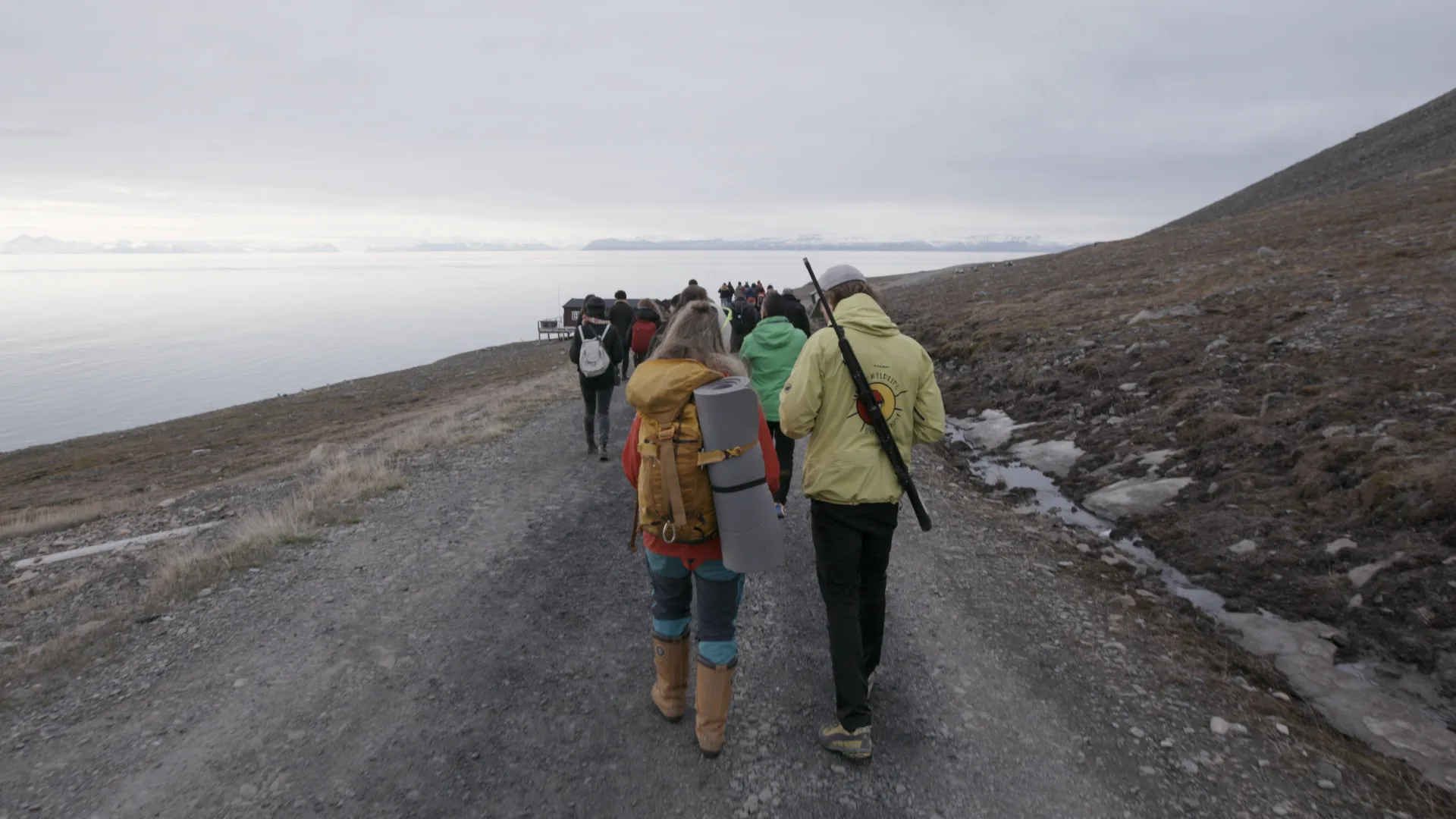
Nature Walk with Elin Øyen Vister © OCA / Cultureshock Media
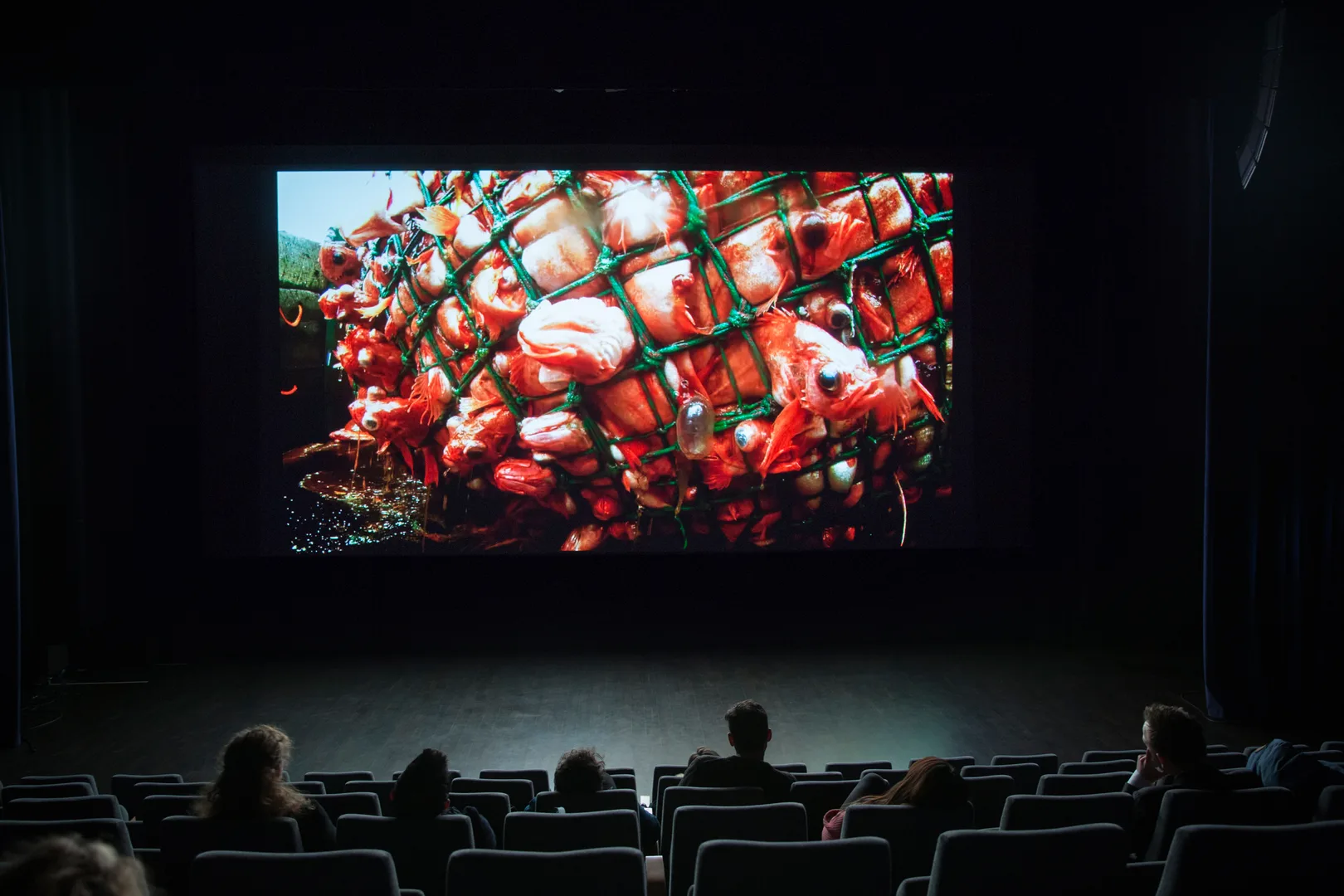
Screening of Leviathan by Lucien Castaing-Taylor and Véréna Paravel © OCA / Herman Dreyer
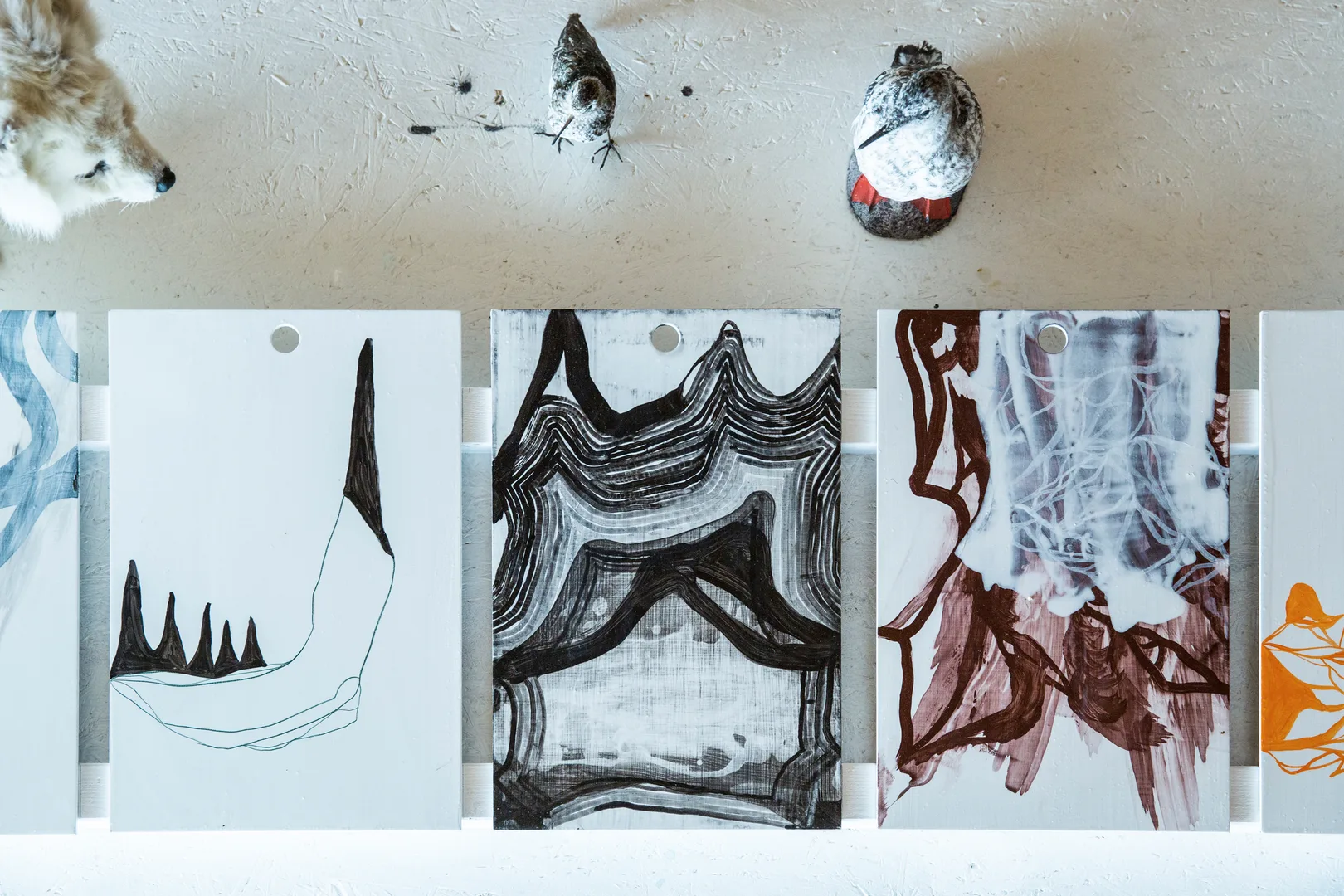
Works on aluminium plate in The Expedition, a solo exhibition by Olav Christopher Jenssen at Northern Norway Art Museum’s Kunsthall Svalbard © OCA / Herman Dreyer